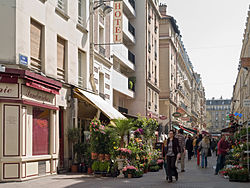Rue Daguerre
Coordinates: 48 ° 50 ' N , 2 ° 20' E
| Rue Daguerre | |
|---|---|
| location | |
| Arrondissement | 14th |
| quarter | Petit-Montrouge Plaisance Montparnasse |
| Beginning | 4-8, avenue du Général-Leclerc |
| The End | 109, avenue du Maine |
| morphology | |
| length | 630 m |
| width | 15 m |
| history | |
| Emergence | before 1730 |
| designation | 1867 |
| Original names | Rue de la Pépinière (Montrouge) |
| Coding | |
| Paris | 2505 |
The Rue Daguerre is a 630 meter long and 15 meter wide street in the 14th arrondissement of Paris .
location

Rue Daguerre is at the intersection of the Montparnasse (north), Petit-Montrouge (south-east) and Plaisance (south-west) quarters . It is located in the immediate vicinity of the Cimetière Montparnasse , which runs parallel only one block further north, and the Catacombs of Paris , the entrance of which is on Place Denfert-Rochereau , only about a hundred meters north of the beginning of Rue Daguerre. The Tour Montparnasse and Gare Montparnasse are also in the immediate vicinity.
Name origin
The street was named in honor of the painter Louis Daguerre (1787–1851), who invented the first marketable photographic process: the daguerreotype named after him .
history
According to the historical city map Plan de Roussel , it already existed in 1730 as a path in the municipality of Montrouge , where it was added to the Paris road network in 1863 in its northern course .
The street was given its current name in 1867. Before that, it was known as Rue de la Pépinière because the nursery of Jacques Philippe Martin Cels' grandchildren was once located at its western end .
The street is home to a large number of small shops (mainly grocery stores for fruit and vegetables, fish, meat, cheese and wine) as well as cafés and restaurants that, compared to other areas, are home to a large number of small shops , especially in the cobblestone pedestrian area near the Denfert-Rochereau metro station from Paris with a comparable standard, are still relatively inexpensive. Nevertheless, the ravages of time are also gnawing at Rue Daguerre, which is evident from the demolition of the formerly covered market in the pedestrian zone to the east of the street in the early 1990s .
Rue Daguerre is a very busy street, during the day because of its numerous shops and in the evening because of the cafes and restaurants. The street freed from its poor past and has developed into a street of the upper middle class from the 1980s onwards.
Attractions
The Rue Daguerre and the streets in its immediate vicinity have always attracted many artists.
- Stéphane Hessel (1917–2013), a resident of the district, was a long-time lover of the 14th arrondissement and rue Daguerre.
- The sculptor César (1921–1998) had a studio in the adjacent Rue Roger
- In a hotel room of unknown house number Für, the anarchist terrorist Auguste Vaillant prepared the bomb in early December 1893, which he wanted to detonate in the semicircle of the Palais Bourbon .
- No. 19: In 1933 this was the seat of the first Algerian political party, Étoile Nord-Africaine . The German painter and graphic artist Hans Hartung (1904–1989) later had his first studio here.
- No. 30: a popular jewelry store
- # 56: Studio Daguerre, a professional photography studio founded in the early 1970s, is historically one of the first rental studios in Paris. Its reputation as a premier fashion photography studio and genealogy make Studio Daguerre a historic address. The studio has trained many photographers and assistants since its inception and had the honor of welcoming great photographers such as Hans Feurer , Helmut Newton , Jean-François Lepage and Peter Lindbergh as well as models and top models such as Naomi Campbell , Monica Bellucci , Dita Von Teese and Estelle Lefébure to be allowed.
- No. 63: The Greek sculptor Takis had his studio here from 1967 to 1992. The painter and visual artist Armand Langlois also had a studio here from 1972 to 1976.
- No. 77: The painters Shirley Jaffe (1923–2016) and Stanley Hayter (1901–1988) had two adjoining studios there, grouped around the garden that stretched behind a mansion that was destroyed in 1970.
- No. 83: The French director Agnès Varda (1928 in Brussels -2019 in Paris ) had a studio here.
- No. 86: Agnès Varda lived here from 1951 until her death at the age of 90.
Web links
Individual evidence
- ^ A b René Léon Cottard: Vie et histoire du XIVe arrondissement. Edition Hervas, Paris 1995, ISBN 2-903118-34-5 , p. 123.
- ↑ Rue du Séjour: Paris XIVème: rue Daguerre (French; article of December 23, 2008)
- ↑ Sabine Chalvon-Demersay, Le Triangle du XIVe , Éditions de la MSH , 1984
- ↑ Chaliand, Gérard, (1934- ...). and Blin, Arnaud, (1960- ...)., Histoire du terrorisme: de l'Antiquité à Daech , Pluriel, 2015/2016, ISBN 978-2-8185-0517-5 and ISBN 2-8185-0517-8 , OCLC 960192775
- ↑ Messali Hadj, Mémoires 1898-1938 , Édition ANEP, Alger, 2006
- ↑ Or du Monde
- ↑ www.studiodaguerre.com/CONTACT
- ↑ An obituary on franceinfo honored the deceased. (French)

